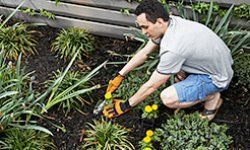 “Start small to learn the basics and you’ll have a gorgeous garden in no time.Chris Clinton/Thinkstock
“Start small to learn the basics and you’ll have a gorgeous garden in no time.Chris Clinton/Thinkstock
A yard full of blooming flowers, fragrant herbs, and edible vegetables may seem out of your reach if you’ve never managed to keep so much as a cactus alive, but a thriving garden is easier than you think – even if you don’t have a green thumb. With a little research and planning, and the right attitude, you can go from brown-thumbed beginner to master gardener in just a few weeks. Here’s how.
Contents
- Get to Know Your Space
- Choose the Right Plants
- Watch for Bugs and Other Problems
- Enlist Your Family
- Enjoy!
Get to Know Your Space
Before you start filling your yard with plants, you need to know which areas are best for planting. Figure which spots get sun and shade throughout the day, and pay attention to where water runoff collects during rainstorms. Whether you want to plant vegetables, trees, ornamental bushes, or flowers, you’ll need to know which parts of your yard are best suited to different plants.
Choose the Right Plants
Once you know your yard, find your climate region on the USDA Hardiness Zone Finder – this will help you look for plants that thrive in your climate (and will stop you from wasting money on a palm tree that fails in your New England winters). Then think about what kind of effort you want to put into your garden and what you want the end result to be: Do you want a magazine-worthy rose garden that requires constant attention? A yard full of perennials you can plant and forget about? Carefully shaped shrubs that take years to fill in? Ask your neighbors, your local nursery owners, and nearby gardeners for their advice, too.
Watch for Bugs and Other Problems
Once you have your plants in the ground, be aware of pest or diseases that could try to undo all your hard work. You can prevent pests with companion planting – pairing plants that help ward off each other’s worst enemies – or by using natural methods like water to deter aphids or beer to capture slugs. To help your plants fight off diseases, make sure they get enough sunlight, are planted in well-drained soil, and aren’t crowded in with each other.
Enlist Your Family
Growing a garden can be a job the whole family works on together, from digging and planting to watering and weeding. Get the kids on board during long, lazy summer days – it will get them out of the house and also teach them plenty about nature, ecosystems, and food culture – and make it fun for them by giving them kid-friendly tools and incorporating plants they’ll love, like strawberries, daisies, and sunflowers.
Enjoy!
Even a beginner’s garden can be a lot of work, so make sure you take plenty of time to appreciate the fruits of your efforts – whether it’s the bright pink blooms on an azalea, fragrant basil from your herb garden, or literal fruit from strawberry plants or blueberry bushes. Start small and work up to more elaborate gardens, and be sure to take photos every year so you can see the progress your garden makes from season to season.
Lots More Information
More Great Links
- How to Start a Garden
- 5 Tips for Beginners on How to Grow an Edible Garden
- Starting a Vegetable Garden
- How to Grow an Herb Garden
Sources
- “Tips for Preventing Garden Pests and Diseases.” TLC. (June 15, 2013) https://tlc.howstuffworks.com/home/tips-for-preventing-garden-pests-and-diseases1.htm
- “10 Plants to Cultivate Your Child’s Interest in Gardening.” Parentables. (June 15, 2013) https://parentables.howstuffworks.com/nesting/10-plants-cultivate-your-childs-interest-gardening.html


